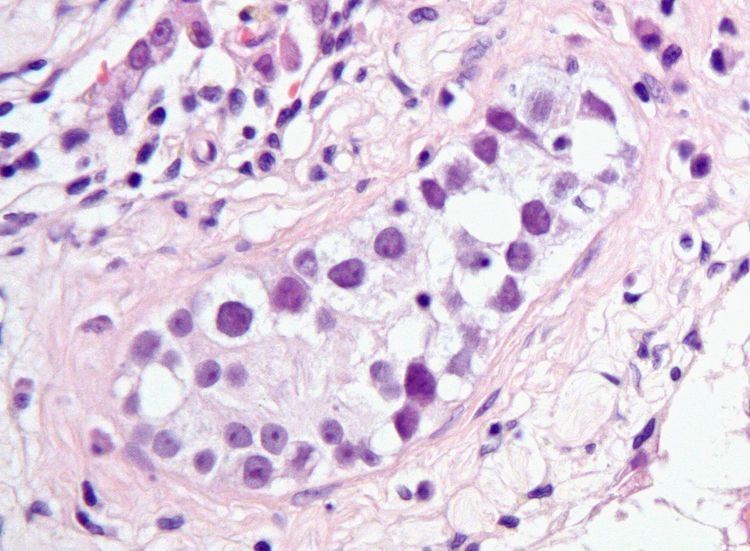 | ||
Intratubular germ cell neoplasia, abbreviated ITGCN or IGCN and also known as testicular intratubular germ cell neoplasia and intratubular germ cell neoplasia of the testis, is considered a precursor lesion for many types of testicular germ cell tumors.
Contents
The common, unspecified variant of the entity was once considered to be a carcinoma in situ although the term "carcinoma in situ" is no longer preferred for ITGCN, unspecified type (ITGCNU) lesions because they are not epithelial lesions.
The entity will be known as germ cell neoplasia in situ (GCNIS) in the next WHO classification which is likely to be published in 2016.
Classification
The World Health Organisation classification of testicular tumours subdivides ITGCN into (1) a more common, unspecified type (ITGCNU), and (2) other specific subtypes. The most common specific subtypes are intratubular embryonal carcinoma and intratubular seminoma.
Cancer risk
ITGCNU is seen in the following settings:
Germ cell tumors that do not arise from ITGCNU
Not all germ cell tumors (GCTs) arise from intratubular germ cell neoplasia. The following testicular GCTs do not arise from ITGCN:
Diagnosis
ITGCN is not palpable, and not visible on macroscopic examination of testicular tissue. Microscopic examination of affected testicular tissue most commonly shows germ cells with enlarged hyperchromatic nuclei with prominent nucleoli and clear cytoplasm. These cells are typically arranged along the basement membrane of the tubule, and mitotic figures are frequently seen. The sertoli cells are pushed toward the lumen by the neoplastic germ cells, and spermatogenesis is almost always absent in the affected tubules. Pagetoid spread of ITCGN into the rete testis is common. Immunostaining with placental alkaline phosphatase (PLAP) highlights ITGCNU cell membranes in 95 percent of cases. OCT3/4 is a sensitive and specific nuclear stain of ITGCNU.
Treatment
ITGCN is generally treated by radiation therapy and/or orchiectomy. Chemotherapy used for metastatic germ cell tumours may also eradicate ITGCN.
